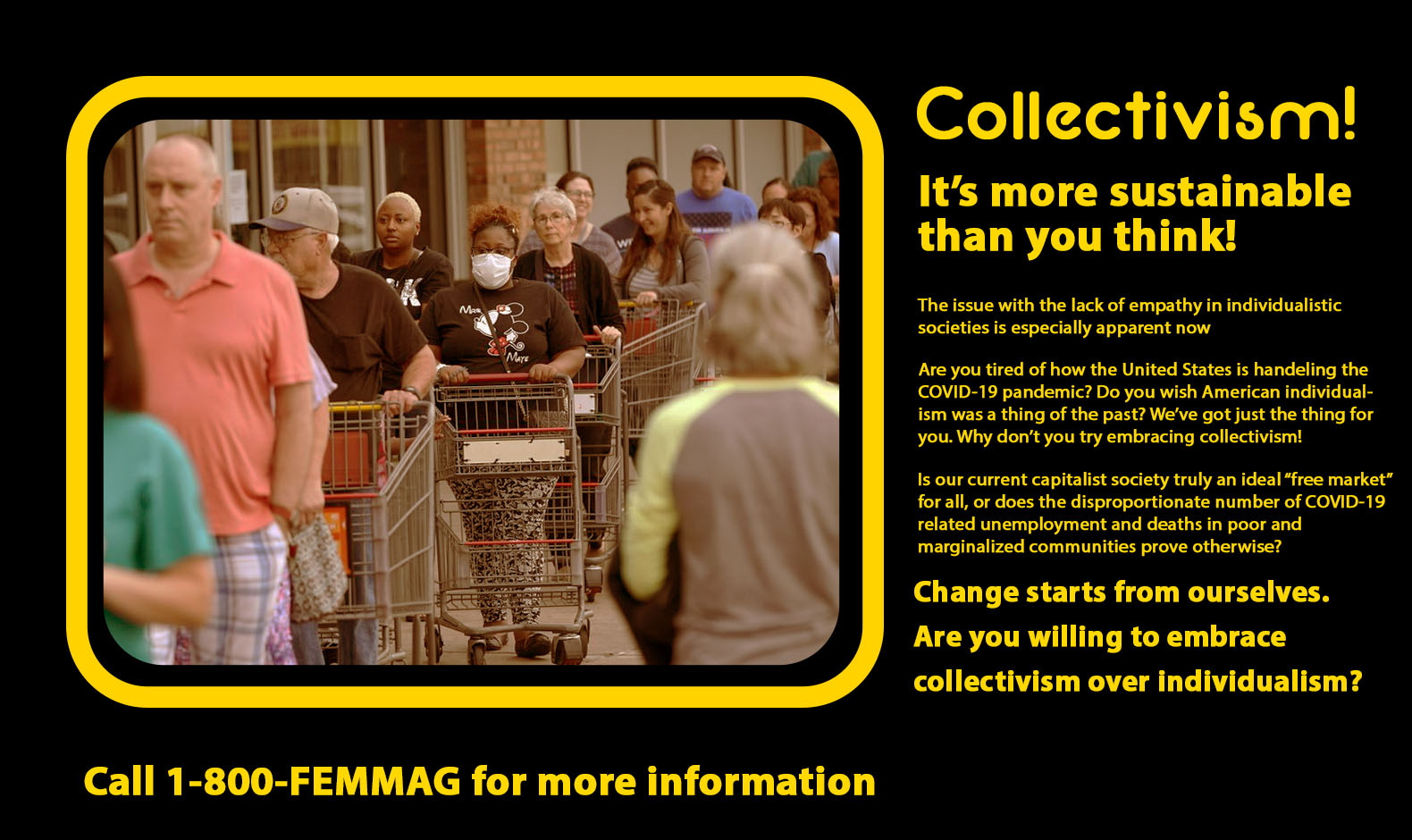Individualism vs. Collectivism

Design by Shannon Boland
Image description: A photo of a single person wearing a mask amongst many unmasked shoppers. The design is stylized like a 70s magazine ad placement advertising collectivism.
Not only did last year’s presidential election prove how divided we are as a country, but our holistic response to the COVID-19 pandemic is another example of the ugliness of individualism.
A collectivist culture — often seen in Asia, Central America, South America, and Africa — focuses on selflessness, collaboration, and common well-being. An individualist culture — often seen in North America and Western Europe — focuses on independence, autonomy, and personal well-being.
In a capitalistic and individualistic society, competition is a driving force for technological advancements and business growth. At the same time, it is the foundation of our superficial education system and apathy toward societal issues.
Finland’s education system is frequently pointed to as an ideal that puts the United State’s public education system to shame. In contrast to the United States’ model of education, Finland’s collaborative and personalized education system humanizes the process of educating students. They do not pit students against each other or measure students’ potential based on a single standardized test score. The Finnish public education system provides personalized support for students and emphasizes test scores and grading less; the government focuses on incorporating education goals into the curriculum rather than on creating quantifiable standards.
Whereas student loan debt makes college education a privilege in the United States, undergraduate and graduate programs are free to students in Finland, which encourages more students to pursue higher education without financial worries.
Students in the United States are taught to be independent and to fight their way into achieving the “American Dream.” Our eurocentric curriculum, racially and socioeconomically-biased tracking system, and underfunding of schools fail to provide all students a rich education, communication skills, and social responsibilities. Annual standardized tests force underperforming students together into large classes taught by less-experienced, newer teachers. These students ironically receive less support and funding because they appear to offer less potential and profit to society. The cultures, histories, and languages excluded from our narrow curriculum leave many students feeling disconnected and obligated to conform to standards that strip away multilingualism, heritage, and identities. Students who are more fluent in foreign languages are placed in ESL classes that condemn rather than celebrate multilingualism.
Our education system reflects the broader problems in a capitalist, individualist society. The tension between the competitive STEM field and the undervalued humanities is the same tension seen among communities in which each individual works for their own benefit. Capitalism’s rigid focus on monetary profit touts STEM careers, which are generally more profitable, as useful and render non-STEM careers useless. This sends the harmful message that the sole purpose of education is to make more money when in actuality, education also serves to connect communities, improve society, develop morals, and enrich lives.
This is also the reason that teachers in the United States receive far less respect and pay than other essential professions like doctors, lawyers, and engineers do. We don’t value education itself as much as we value the profitability of certain fields. American teachers are often overworked, underpaid, and responsible for addressing students’ socioeconomic and emotional struggles.
Transitioning to a more recent example, the 486,000 COVID-19 deaths in the United States as of Feb. 16 is a further revelation of how an individualistic culture can harm an entire nation at times when collectivism is needed.
Taiwan has successfully responded to the pandemic. As of Feb. 16, Taiwan has had only 9 COVID-19 deaths. Not only did this success depend on effective leadership, it also depended on the compliance of residents. According to an article on CNBC, “It’s become part of the culture in Taiwan to name and shame those who are not wearing masks in the subway or are breaking quarantine early.” The sense of social responsibility amongst the masses ensures that outliers who refuse to follow safety regulations will not harm the community.
In Taiwan, there is “a strong feeling that sometimes people have to give up their ‘individual desires and benefits’ for the sake of their community,” the article continues. This willingness to sacrifice for the common good is exactly what our current American society needs to balance out the ruthless, self-serving mindset possessed by anti-maskers, anti-vaxxers, and corporations that have capitalized on the pandemic situation.
Despite being the first country to identify the outbreak of COVID-19, China has similarly dealt with the spread of COVID-19 with speed and efficacy.
“The country has reported 86,212 confirmed cases and 4,634 deaths since the pandemic started,” according to NBC News on Nov. 7, 2020, which is a stark contrast to the staggering number of deaths the United States has faced.
Ali Mokdad, a global health professor at the University of Washington, has praised China’s effective control of the spread of COVID-19. However, he notes that this level of restriction on citizens’ freedom would never be tolerated in the United States; it would be considered an infringement on personal freedom. In contrast to China’s one-party government, the United State’s divisive political parties and emphasis on states’ rights make it harder to display unity when necessary.
Seeing references to China and the term “collectivism” paired together might generate a fight-or-flight response to the implication of communism. The fear of an authoritative government controlling one’s thoughts and actions is an example of common misconceptions Western countries like the United States have of socialism and communism.
Just as many believe that communist governments feed propaganda to their citizens, Western governments similarly produce propaganda against socialist and communist ideologies that pose a threat to capitalism.The United States viewed communism and socialism as a threat to capitalists accruing individual wealth, and propaganda vilifying communist and socialist ideologies throughout the Red Scare established the unreasonable aversion to these political labels.
Is our current capitalist society truly an ideal “free market” for all, or does the disproportionate number of COVID-19-related unemployment and deaths in poor and marginalized communities prove otherwise?
We must focus on describing what our ideal society looks like rather than on attaching stigmas to different political terms. This stubbornness and ignorance will continue to harm us if we don’t start learning from the positive and beneficial aspects of other countries and cultures.
What has shown to be more effective in combating issues like COVID-19 is not just a swift implementation of preventive measures, but also a collectivist, collaborative, and empathetic culture shared among residents. Comparing the COVID-19 statistics of other individualist countries like the United Kingdom (4.05 million cases and 117k deaths as of Feb. 16) to a collectivist country like South Korea (84,325 cases and 1,534 deaths as of Feb. 16) is further proof.
Despite also being a capitalist society, South Korea’s “local governments have limited autonomy and its public health governance is centralized,” which allowed South Korean agencies to efficiently implement health policies at the local level during the COVID-19 outbreak, according to University of Colorado Denver researcher Jongeun You. Similar to Mokdad’s acknowledgement earlier, You said, “‘South Korea’s extensive surveillance and contact tracing using ICT (information and communications technology) may not be applicable at the federal level in the U.S. due to different cultural norms.”
However, such widespread recognition of the United States having an individualist culture does not mean that we cannot adopt more collectivist mindsets and practices starting now.
The United States’ heterogeneous population means that we might have to collectivist places like South Korea, Taiwan, and China that have more homogeneous populations. Racial, cultural, and language differences divide us even more within our competitive, capitalistic society and complicate the process of feeling unified as one community. This emphasizes the need for us to come together to fight against racial and socioeconomic inequities, and if anything, manifest more empathy.
When one says, “I have the freedom and right to not follow government orders and safety regulations,” I hear, “I prioritize my comfort over the lives of others because I have grown up in a society where empathy is unprofitable and therefore unimportant.” Change starts from ourselves; even during periods when stay-at-home orders are lifted, ask yourself if you really need to go out and gather or if you can spare more consideration for essential workers and lessen the risk for those around you. In the process of establishing a more collectivist society, we must realize that the ideal is for the whole to thrive — not just the individual.




